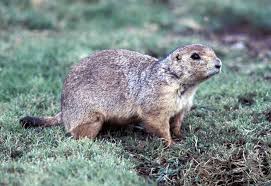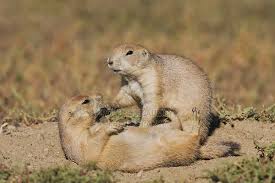
Mexican prairie dog
(Cynomys mexicanus)

The Mexican prairie dog is a diurnal burrowing rodent native to Mexico. Treatment as an agricultural pest has led to its status as an endangered species. They are closely related to squirrels, chipmunks, and marmots.
Conservation status
Endangered
Scientific classification |
|
| Kingdom: | Animalia |
| Phylum: | Chordata |
| Class: | Mammalia |
| Order: | Rodentia |
| Family: | Sciuridae |
| Genus: | Cynomys |
| Specie: | Cynomys mexicanus |
Description

Mexican prairie dogs are similar in color to black-tailed prairie dogs, with reddish-brown fur throughout the body with lighter color on the underside. Slightly smaller than the black-tailed prairie dog they are distinguished by the black-tip tail covers half of tail whereas the black tail tip covers only the last 1/3 of a black-tailed prairie dog tail.
Habitat and diet

These prairie dogs prefer to inhabit rock-free soil in plains at an altitude of 1,600-2,200 m (5,200-7,200 ft). They are found in the regions of southern Coahuila and northern San Luis Potosí in northern Mexico, where they eat herbs and grasses native to the plains where they live. They acquire all of their water from these plants. Although mainly herbivores, they have been known to eat insects or (very rarely) each other.
Predators include coyotes, bobcats, eagles, hawks, badgers, snakes, and weasels.
Lifecycle and behavior

Northern prairie dogs hibernate and have a shorter mating season, which generally lasts from January to April. After one month's gestation, females give birth to one litter per year, an average of four hairless pups. They are born with eyes closed and use their tails as visual aids until they can see, about 40 days after birth. Weaning occurs during late May and early June, when yearlings may break away from the burrow. Pups leave their mothers by fall.
As they grow older, young play fighting games that involve biting, hissing, and tackling. They reach sexual maturity after one year, with a lifespan of 3-5 years; adults weigh about 1 kg (2.2 lb) and are 14-17 inches long, and males are larger than females. Their coloring is yellowish, with darker ears and a lighter belly.
Prairie dogs have one of the most sophisticated languages in the animal world a system of high-pitched yips and barks and can run up to 35 miles per hour (56 kilometres per hour). As a consequence, their defense mechanism is to sound the alarm, and then get away quickly.
Reproduction

Mexican prairie dogs breed once per year in mid-January to early April. Gestation is estimated at 30 days and average litter size is 4 pups. Females lactate for 41-50 days. Juveniles emerge aboveground in April.
Social structure
Mexican prairie dogs live in excavated colonies, referred to as "towns", which they dig for shelter and protection. A typical town has a funnel-like entrance that slants down into a corridor up to 100 ft (30 m) long, with side chambers for storage and nesting.Towns can contain hundreds of animals, but generally have fewer than 50, with a single alpha male. Sometimes, spotted ground squirrels or burrowing owls share the burrow with its rightful owners.
Populations
Decline
In 1956, the Mexican prairie dog was reported as occurring in Coahuila, Nuevo León, and San Luis Potosí. By the 1980s, it had disappeared from Nuevo León, and its complete range was less than 800 km2 (310 mi2). Viewed as a pest and an obstacle to agriculture and cattle raising, it was frequently poisoned, and became endangered in 1994. Mexican prairie dogs currently inhabit less than 4% of their former territory.Conservation
The current habitat of Mexican prairie dogs is in the region known as El Tokio. These are the grasslands located in the convergence of the states of San Luis Potosí, Nuevo León, and Coahuila. Conservation groups such as Pronatura Noreste and Profauna, with the help of donors, carry out conservation efforts for the protection of prairie dogs and associated species, such as shorebirds and birds of prey. Pronatura Noreste, as of February 2007, has signed conservation easements with ejidos and private owners for the protection of more than 42,000 acres (170 km2) of Mexican prairie dog grasslands.Zoológico de Vallarta A. C.
Leave your comments, your opinion is important to us

